Translator,
PhD candidate,
Universite de Montreal, Canada
sanaa_benmessaoud@yahoo.ca
1- Introduction
Far from suppressing the need of translation, globalisation has boosted the demand for it. Just as the slogan ‘think globally, act locally’ goes, businesses have to go global to expand and this requires the tailoring of their products to local markets’ idiosyncrasies, including linguistic ones. Thus, the demand for translation has rocketed (see Austermühl, 2001). Besides, Companies are increasingly aware of the financial profitability of integrating translation in their marketing plan, and many are targeting simultaneous release of foreign language versions of their products. Consequently, translation is, for many companies, not an afterthought but an integral part of the production cycle (see Brooks, 2000), and translation deadlines are thus getting tighter and quality criteria higher. The progress achieved at the level of information and communication technology has also had a drastic impact on translation as a profession. Nowadays, translation teams have become global and virtual. ‘[W]ith so many factors interacting in the translation process, project management emerges as the key element marrying crafts, needs, and expertise’ and project managers have ‘to plan, instruct, monitor, and control large amounts of data quickly and accurately, while facilitating the problem-solving and decision-making process’ during the translation project (Perez, 2002).
In this article, I will attempt to highlight the importance of project management for modern translation projects, and investigate whether and in what way CAT tools are beneficial to project managers . For reasons of space, I will focus on Translation Memory (TM) tools Star Transit, Trados Translator’s Workbench, and Atril’s Déjà Vu (DV), and on the localization tool Passolo. I will draw mainly on my own experience as a translator and a project manager. It is noteworthy that for the purposes of this article, a translation project refers to technical translation and software localization projects but excludes engineering matters involved in the latter, since I will tackle the issue from the perspective of a translator.
2 - Project Management
The Project Management Institute (PMI) (2000: 6) defines project management as ‘the application of knowledge, skills, tools and techniques to project activities to meet project requirements’. In the translation profession, the greater the size and scope of a project the more important management gets, and though this management is not directly related to the act of translating, it is essential to the success of a project (Melby, 1998). In fact, a large-size project requires many translators, some of whom may be outsourced. This increases the cost as well as risk and necessitates an optimal control of all the phases of and elements involved in the project. Accordingly, and though project management is a relatively new practice in the translation profession, it is increasingly necessary.
3 - Project Management in Translation
Project management in translation, like in all other professions, is subject to the ‘Triple Constraint’ (Rosenau, 1992: 15) of time, cost and quality. A translation project is only successful when it is completed ‘on schedule, within the budget, and according to previously agreed quality standards’ (Esselink, 2000: 429). A project manager will, thus, be required to plan the budget, track the workflow to ensure the project is completed on time, and control all the phases of the project to make sure its outcome will meet the client’s requirements.
Perez (2002) breaks down a translation project’s life-cycle into five phases: commissioning, planning, groundwork, translation and wind-up.
Translation Project’s Life-cycle (adapted from Perez (2002))
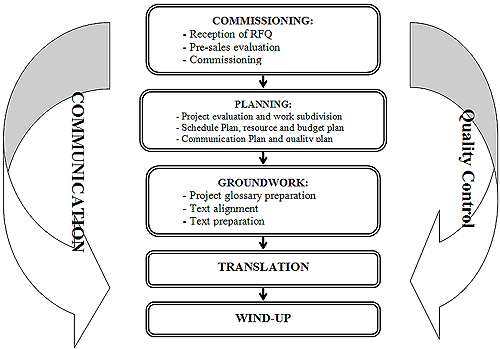
3. 1. Commissioning
A Request for Quotation (RFQ) is the first step towards commissioning. Upon reception of this request, the translation-services provider has to carry out a ‘pre-sales evaluation’ (Esselink, 2000: 429). The project manager has to evaluate the scope of the project in order to draw an accurate quotation for the client. But before embarking on this task, s/he has to ensure that s/he received all the necessary information, including the full source material, the target language(s), information about the function of the translation, any potential updates during the project’s life-cycle and any existing glossaries or translation memory. It also includes the client’s requirements mainly in terms of time, deliverables and services such as glossaries and/or a translation memory. The project manager has also to take into account internal factors that may have an incidence on the time and budget such as other on-going projects.
The project manager needs then to evaluate the translation volume. The role of CAT tools is invaluable at this level. In the case of software localization, Passolo, for example, gives the total number of strings and words to be translated and of internal matches. Besides, the Auto-Translate function in it allows the use of a glossary, when provided by the client, and thus the calculation of how much of the translation can be leveraged. Trados Translator’s Workbench, DV and Star Transit are equally equipped with a word-count utility that provides detailed statistics, including internal and external matches, which is beneficial in the case of updates during the project. Trados and DV, in fact, can provide statistics for several files at the same time, while Transit offers an extra feature that enables the project manager to calculate the cost per unit per language.
Star Transit Report
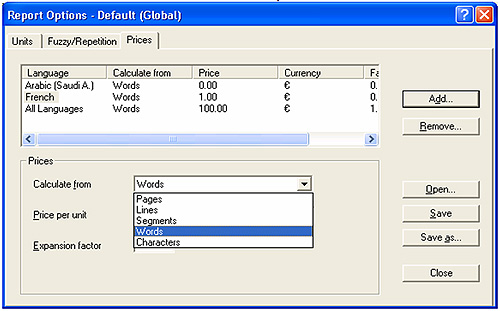
However, the project manager should be very careful while generating word counts by means of such tools, especially when dealing with websites. Different tools can generate different word counts. Table 1 below shows how the three tools above yielded different statistics for the same HTML source file.
Table 1
Star Transit | DV | Trados Translator’s WorkBenchh | |
Total number of words | 85 | 152 | 96 |
This difference stems from what each tool considers as one word and from differences at the level of identifying translatable text. Discrepancy may also exist at the level of external matches due to differences between tools in text segmentation. So when the project manager is creating a quotation, s/he should use more than one tool and, if possible, use the same word count tool used by the client.
Once the project manager has determined the translation volumes and identified all the client’s requirements as well as all the elements that will be involved in the project, s/he can draw a detailed quotation.
3.2. The Planning
According to Esselink (2000: 438), the first task a project manager should perform at this phase is another project evaluation that aims at identifying the client’s needs and objectives from the project. Drawing on Hewlett Packard’s experience in project management, David Packard (cited in Combe, 2000: 99) argues that ‘management by objective’, which he defines as ‘a system in which overall objectives are clearly stated and agreed upon’ is the best way to implement projects successfully. By identifying the clients’ short- and long-term goals, project managers are better positioned to plan the project, adequately subdivide the work involved in it and foresee any future scalability needs they may have (Perez, 2002).
Work subdivision is the second task in the planning phase. Indeed, since translation projects, especially large-size multilingual projects, necessarily involve risk, project managers should adopt a ‘work breakdown structure for subdividing the project’s scope of work into manageable phases or work packages’ (Burke: 24). In the planning phase, therefore, the project manager should identify the different work packages (WP) necessary to complete the project. This will allow him/her to create an accurate schedule plan for the project, draw sound resource and budget plans, and create a communication plan that allows him/her to keep track of the workflow and to give feedback on the project’s progress to the client.
The project manager should also draw a quality assurance (QA) plan, which consists in ‘evaluating overall project performance on a regular basis to provide confidence that the project will satisfy the relevant quality standards’ (PMI, 2000: 190). These standards differ from one client to another and even from one project to another, so the project manager has to ensure she draws a quality plan that is consistent with clients’ definition of quality (what is a critical error for them, for example) and that addresses their needs.
On the other hand, a project is an integral whole and all its phases are necessarily interrelated. Consequently, the project manager has to take account in the schedule plan of both dependencies and sequences (Esselink, 2000: 444), i.e. which WP or activity depends on the completion of what other WP or activity, and the sequence these activities must take. In a localization project, for example, documentation files cannot be translated until the software has been translated and proofread. Failure to identify dependencies and sequence may be detrimental to the project in terms of time and even of quality. During a classroom website localization project, the text in one HTML file recurred in three other pages translated by three different translators. To guarantee consistency and save effort, the project managers asked the translator of this file to send his TM to the other three translators so that they could use it. Since the translation that generated this TM had not been proofread, the errors it contained were repeated in the translation of the three other files and the senior translator had to proofread the same text four times. By failing to identify the dependency of the translation on the proofreading, time and effort that could have been saved were wasted.
Another key task a project manager has to do in the planning phase is to create a project folder where to put all files pertaining to the project, including all the files received from and sent to the client, all files sent to and received from the translators, the terminologist and the senior translator/proofreader, TMs and glossaries and all the plans outlined above. A central folder allows a better control of the workflow. The folder below was created for the same website localization project mentioned above:
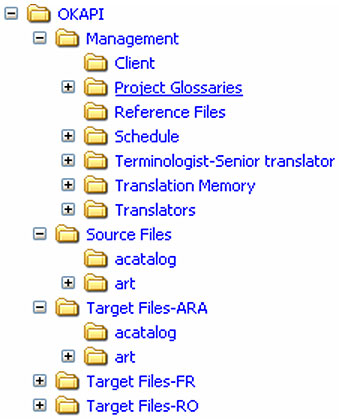
3.3. Groundwork
Groundwork is as critical a phase in the project’s life-cycle as the planning phase. It consists of several WPs, including glossary preparation and text preparation. The manager has to supervise terminology set up and the creation of bilingual or multilingual glossaries. If the client does not have an existing glossary and does not provide a terminology list, the manager will have to compile a specialized terms list by extracting relevant terms. This operation can be done either manually, via the macro function in MS Word, for example, or automatically by means of a term extraction tool. This list is then handed to the translator(s) working on terminology in order to build a project glossary according to the schedule plan. The project manager has to make sure the former has got all the necessary reference material to check terms against their context so that s/he can provide accurate equivalents. Some CAT tools even allow term extraction from previously translated material and their transfer to integrated terminological databases.
In DV, Trados MultiTerm or Star TermStar, and if the client provides a glossary, the project manager can easily import it and include other candidate terms in it before sending it to the translator in charge of terminology to look for equivalents. Terminological data exchange is easy between these tools as they support various formats, mainly txt. and xls. On the other hand, and as mentioned above, the text alignment utility, offered by these three TM tools allows the project manager to align previous versions of the source material and their translation, when available, match source language segments with their translation and feed the matching segments into a translation memory database that can be sent to translators along with the project glossary and the translatable text. As for Passolo, the project manager can use an existing glossary as a base and add terms to it in a txt. format easily imported in Passolo and linked to the project.
TM tools are also useful in text preparation. Thanks to their filters, they support various file format including tagged files, and allow the project manager to extract source files, separate translatable text from formatting information and convert the files ‘from [their] proprietary format to a format that can be read by the TM system’ (Esselink, 2000: 362), which helps preserve the original layout and protects tags against accidental modification or deletion. They also allow the segmentation of source texts following the solution’s algorithm so that texts are broken into segments easily compared to entries in the TM database. More importantly, they generally allow the setting up of multilingual projects in one go, like it is the case with Star Transit. Passolo, too, allows the preparation of files (EXE, DLL or OCX) for translation in several languages in one operation. The Translation Bundle feature it offers also enables the project manager to package all information and data necessary for the translators, like translation lists, project glossaries and notes for translators, in a single file.
However, text preparation may encounter problems sometimes. While working with Transit on a classroom translation project that included HTML and PowerPoint files, the project manager created a multilingual project following the appropriate procedure and sent them to the translators, in one package. But when the translators opened the files in the Transit editor, the latter could not recognise the PowerPoint files. The project manager had to go through the text preparation phase a second time and set up a separate project for each file format. This took her more than the time initially scheduled for this phase.
3.4. Translation
The translation phase is the backbone of a translation project. While communication, both external, i.e. with the client, and internal, i.e. with the project team members, is very important throughout the project’s life-cycle, its role in the translation phase cannot be stressed enough. The project manager has to ensure that the translators have all necessary information pertaining to the project, including its objectives, deadlines, the frequency of feedback and the function of the translation. S/he should keep all translators in his/her team updated of any development that might affect the translation. Any breakdown at the level of communication may have significant consequences. During the same website localization project mentioned above, translators were given instructions not to change file names but were not given the reason for this instruction. They failed thus to see the importance of such a measure and changed the file names, which meant that hyperlinks would not work and that the names had to be restored by the project managers.
The role of CAT tools at this level is invaluable for the project in terms of time, quality and cost. In the past, translators had to rely fully on their memory to remember how they translated a repeated sentence, or they could use the search function in MS Word to locate such sentences and check how they translated them in order to be consistent in their translation. They also had to look up words manually in print glossaries or dictionaries, or automatically in terminological databases in such non-specialized applications as Access, Excel or Word. With the advent of CAT tools, much of such manual or repetitive work has been eliminated. TM tools, including DV, Star Transit and Trados Translator’s Workbench, for example, allow the leverage of previously translated material and its reuse to translate updated or similar versions thanks to their text alignment features. A repeated sentence within the same text has to be translated only once by the translator as it will be stored in the TM database and automatically displayed at its following occurrence in the text, thanks to the fuzzy matching function. Besides, project glossaries are linked to the TM systems, which allows the automatic display of recognized terminology. More importantly, translation memory and terminological data exchange is possible between various CAT tools. Thus, in software localization, for instance, Passolo allows through its Add-ins for TM systems, the export of the glossary to terminology databases in Trados MultiTerm and Star TermStar, as well as the export of complete sentences and phrases to the TM system in Star Transit and Trados Translator’s Workbench. In sum, these tools improve productivity by ‘30% or even 50%’ and reduce the cost ‘by 15% to 30%’ (Esselink, 2000: 366).
3.5. Wind-up
The wind-up phase is the last in the project’s life-cycle but not the least important. The project manager has to carry out a number of tasks at this level. S/he has to ensure that translators have reviewed their work and run a spell-checker available in most TM tools and that the senior translator has edited the translation. S/he has also to check hyperlinks, in the case of website localization, and test applications in the case of software localization. S/he has to give samples to the client for further review according to terms set at the start of the project, and undertake overall quality checks according to the QA model s/he endorsed. Assessing quality in translation is particularly difficult inasmuch as criteria and requirements differ from client to client and even from translation-services provider to another. There are, however, certificates that are increasingly used in translation projects, including DIN 2345, ISO 9002 (Perez, 2002 and Esselink, 2000) and reliable QA models for localization projects. The LISA QA is one of these models. It is based on a sampling method and categorizes errors into five distinct categories: grammatical and typing quality, mistranslation, style and country-specific standards (Koo and Kinds, 2000: 174). According to this model, a quality check is carried out twice in the project’s life-cycle ‘on the translations when first submitted, and on the final product’. Errors are further rated as critical, major and minor. Such a model is very useful to project managers inasmuch as it outlines criteria and categories and allows the rating of errors. Reviews and revisions are no more random and can be controlled.
The greatest advantage of CAT tools at this stage is undoubtedly their ability to preserve the layout of the source file. Traditionally, translators had to do all the layout work manually once the translation is finished, which used to take a lot of time and effort. With CAT tools, including those reviewed in this essay, the project manager can easily reapply the formatting information, which s/he separated from the text in the text preparation phase, to the translation thus yielding a target text in the original format.
Conclusion
I would conclude that project management is a complex operation that involves the control of interrelated elements, coordination between several people and adequate and speedy circulation of relevant information. It is about teamwork and partnership between the project manager and the client, on the one hand, and between project managers and the translators, on the other. But it is mostly about preparation since ‘proper preparation before the start of translation is the key to a successful project’ Luong (cited in Bernacchi). In this operation, CAT tools prove to be very valuable especially as far as the language elements in the project are concerned. However, such a value can be decreased or increased depending on the expertise of translators and project managers alike in dealing with them. Not knowing how to handle these tools may turn them from an asset into an obstacle.
Bibliography
Austermühl, F. (2001) Electronic Tools for Translators, Manchester: St. Jerome.
Bernacchi, M. C. ‘Strategies and Tools’, retrievable from http://www.uwm.edu/~vanpelt/mcbernac/tools.html [accessed in May 2004].
Brooks, D. (2000) ‘What Price Globalization: Managing Costs at Microsoft’, in R. C. Sprung (ed) Translating into Success: Cutting-edge strategies for going multilingual in a global age, Amsterdam and Philadelphia: John Benjamins Publishing Company.
Burke, R. (1999) Project Management: Planning and Control Techniques, Chichester and New York: John Wiley and Sons LTD.
Combe, K. (2000) ‘Localization at Hewlett-Packard’s LaserJet Solutions Group’, in R. C. Sprung (ed) Translating into Success: Cutting-edge strategies for going multilingual in a global age, Amsterdam and Philadelphia: John Benjamins Publishing Company.
Esselink, B (2000) A Practical Guide to Localization, Amsterdam and Philadelphia: John Benjamins Publishing Company.
Koo, S. L. and Kinds, H. (2000) ‘A Quality Assurance Model for Language Projects’, R. C. Sprung (ed) Translating into Success: Cutting-edge strategies for going multilingual in a global age, Amsterdam and Philadelphia: John Benjamins Publishing Company.
Melby, A.K. (1998): Eight Types of Translation Technology, retrievable from http://www.ttt.org/technology/8types.pdf [accessed in May 2004].
Perez, C. R. (2002) ‘Translation and Project Management’, The Translation Journal, V 6, no 4, retrievable from http://accurapid.com/journal/22project.htm [accessed in May 2004].
Project Management Institute (PMI) (2000): A Guide to the Project Management Body of Knowledge (PMBOK), Newtown Square: Project Management Institute.
Rosenau, M. D. (1992) Successful Project Management: A Step-by-Step Approach with Practical Examples, New York: Van Nostrand Reinhold.
Appendix 1
Report by Déjà Vu
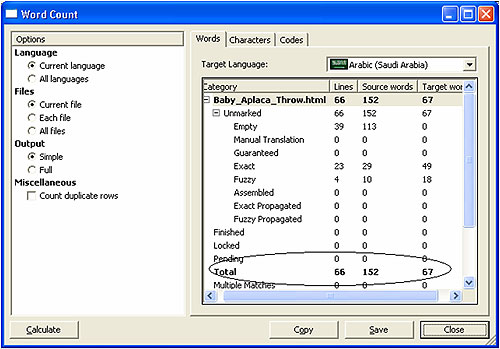
Report by Trados Translator’s Workbench
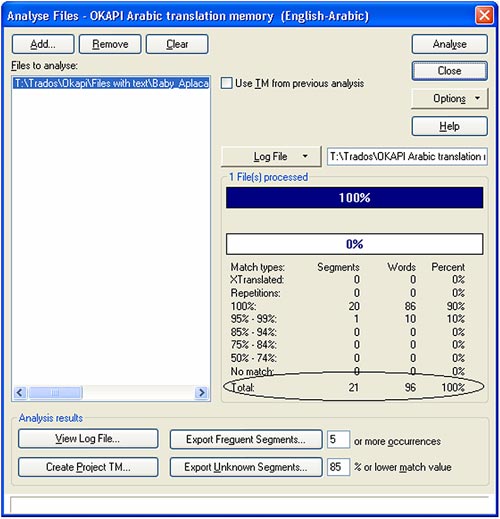
Report by Star Transit
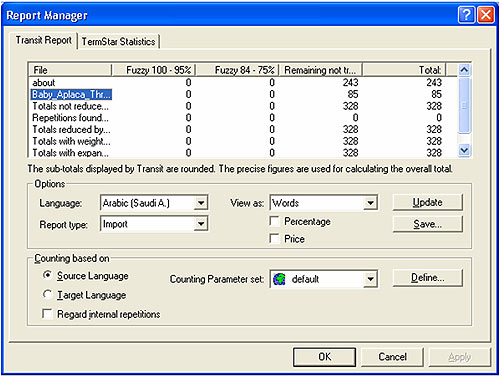







No comments:
Post a Comment